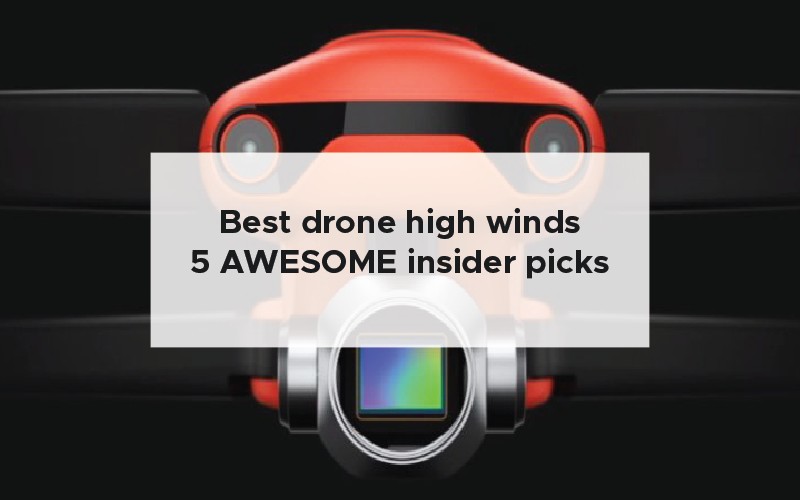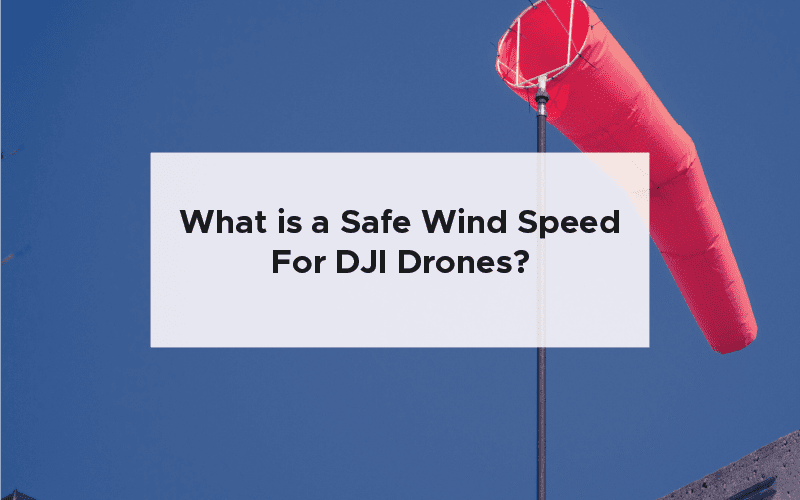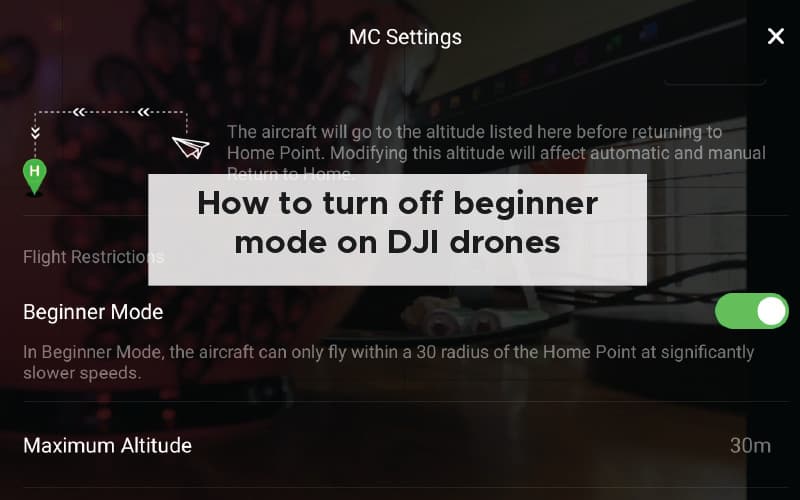Sometimes I look out the window, and I see the trees blowing and wonder if it is safe to fly my drone. When deciding whether or not I can fly my drone on a windy day, I consider a range of factors, including the wind gusts and wind speed. I also check for changing weather. Higher wind speeds often mean a first changing weather pattern that can bring rain. I avoid rain at all costs.
You can fly your drone on a windy day as long as the maximum wind predicted does not exceed two-thirds of the maximum flight speed of your drone. This rule of thumb will ensure you have enough power to safely and stably fly your flight mission.
Anything above a force seven wind which is approximately 17 to 20 m/s (38 – 45 mph), is far too high to be flying a drone.
Another way to approach this question is to consider whether or not you feel safe flying your drone in the current conditions. As drone pilots, we pick up lots of experience, and if you have not flown in conditions even close to the current wind speed, I would advise against taking off.
Suppose at any time during your flight you decide that the drone is behaving erratically or you are unable to control the drone predictably. In that case, you have the option of returning to the takeoff spot as quick as possible. Never risk your drone or personal injury for the sake of a drone flight. There is always another day.
The ultimate objective decider of whether or not your drone can fly in the current wind speeds is the top speed of your drone.
Top speed of your drone
The drone wind resistance level very much depends on the top speed of your drone. It also depends on the acceleration of the drone’s motors to combat wind gusts.
You will often see manufacturers quote the wind resistance in terms of a level. This level is known as the Beaufort scale. It is an empirical measure that relates wind speed to the observed conditions, whether at sea or on land.
The strongest wind gust ever recorded was 231 mph, about 103 m/s. You would never consider flying a drone even close to that.
While flying, your drone will likely give you warnings on the first person view video display. While flying my DJI Mavic air, I have received high wind warnings and was told to land as soon as possible. The drone is calibrated to be safe, and I often feel comfortable dismissing the warning and continuing with my flight.
You’ll get a sense of what your drone is capable of the more you fly it and the higher wind speeds you face.
To give you an idea of popular drones’ general wind speeds and wind resistance, I have tabulated them below.
Wind resistance of popular drones
Drone manufacturers often list the maximum wind resistance from the specifications on their website. Different drone models have different power outputs, and you should look for the number that specifically relates to your drone model and make.
| Drone | Maximum speed | Wind resistance |
| Mavic Mini | 13 m/s | 8 m/s |
| Mini 2 | 16 m/s | 10.5 m/s |
| Mavic Air 2 | 19m/s | 10.5 m/s |
| Mavic Pro Platinum | 18 m/s | 10 m/s * |
| Mavic Air | 19 m/s | 10.5 |
| Parrot Anafi | 15 | 14 |
| DJI inspire | 25 | 10 |
| DJI Phantom 4 Pro V2.0 | 20 | 10 |
| DJI Phantom 4 RTK | 31 | 18* |
| DJI Matrice 300 RTX | 23 | 15 |
| Autel Evo 2 Pro | 20 | 17 -20 m/s (Force 8) |
*calculated 2/3 maximum speed
Sometimes you try your best not to fly in high winds, but at times it is inevitable. This issue is particularly true if you are running to a tight deadline for your drone mission or freelancing as a drone pilot and the location and videography brief dictate a certain time and place.
If you find yourself flying on the limits of your drone’s capacity or need to get the job done in adverse weather conditions, here are several tips for flying in high winds.
There are some important considerations every drone pilot needs to make if they are flying at the technological limits of the drone they send into the air.
Some of the considerations below may surprise you. Make sure you read all of them to prepare for your next high wind day fully.
If you want to know more about the best drones for high winds check out my five awesome options here.
Considerations for a windy day
Flying your drone on a windy day means that you need to be mindful of issues that often don’t matter on a clear sunny day. Changing weather, errors, and fast depleting batteries will be the hardest issues to combat.
Here is an in-depth rundown of all of the top considerations if you want to fly your drone on a windy day.
Changing weather
Drone flights can last up to 40 minutes, and the weather can change dramatically in that time.
On a windy day, the weather will likely change much faster than you think. Once I was flying my drone in the sunshine on a relatively windy day when a huge isolated thunderstorm decided to pass bright overhead. Because I was so engrossed in the flight, I only just managed to land and save my drone from an absolute drenching.
Should you be flying on a particularly windy day, check the rain radar and weather predictions for the entire flight and factor in that they will change rapidly.
Isolated thunderstorms that pass overhead quickly are the most threatening weather patterns for your drone. I highly recommend avoiding flying even if there is the smallest chance of getting your drone wet. Your drone is very vulnerable to water damage.
Leave more space for errors
Your drone is likely to have a GPS stabilisation and altitude hold feature. Your drone is constantly trying to keep itself in stable flight. The software needs to react quickly to anomalies in the drone’s movement caused by wind and gusts. The sensors send signals to the flight control unit, and the motors need to spool up to counteract the movement.
The whole process takes only a fraction of a second, but the drone can move a considerable distance if it is particularly windy in a fraction of a second.
I highly recommend giving obstacles in your flight path a particularly wide berth while flying in high winds. Do not get any closer than approximately 5 m to trees, walls, powerlines, or other overhanging or solid obstacles.
I mention trees in particular because, in high winds, trees are prone to shedding leaves and other debris that could get into your drone’s propellers and cause you significant issues while taking off.
The battery won’t last as long
The motors are going to be working harder in high wind situations. The motors draw the power required from the battery. Extra stabilisation means that the battery will deplete much faster than in calm conditions.
The extra battery power required for stabilisation directly impacts your flight mission.
It would help if you did not venture too far away from your takeoff location. In high wind conditions, your flight mission should stay much closer to the takeoff spot than you are used to.
You can overcome the extra drain on the battery by carrying extra batteries with you or purchasing an in-field battery charger for your car.
Head out against the wind
one of the most important aspects of flying your drone in high winds is to ensure that your flight mission starts with the outward journey against the wind.
Drone software does not consider the extra energy required to combat a headwind. It is much better to deplete the energy in the first half of your flight fighting against the headwind than it is to realise your drone will not make it home with the battery reserves when you are trying to return to the landing spot.
To know which way the wind is coming from turnaround into you feel the wind on your face. That is the direction you will want to send your drone early on. Having a tailwind on the return journey will make it much easier and safer for your drone to return to its landing spot and fly another day.
Pay particular attention to the wind direction if you are flying over water. When flying over water, you cannot land early, and it will be the end of your drone. Unless you have drone insurance, you’ll have to buy a completely new drone.
Stay away from updrafts
The interaction of strong wind with geological features can create strong updraughts. Drones can overcome sideway forces but have a much harder time dealing with buffeting up and down.
You’ll find updraughts near cliffs and rock faces. Particularly common near the ocean.
My recommendation is to stay away from any areas which have a significant updraught to make your drone flight a safer one.
![Can you fly a drone on a windy day? [Secrets for safety]](jpg/can-you-fly-a-drone-on-a-windy-day-2-1024x683.jpg)
You can also get significant updraughts in cities if you are flying your drone near the edge of a building. Wildlife is a useful indicator of updraughts as birds will often use updraughts for gaining altitude without flapping. If you see some birds hovering in the air, be careful near them.
Turn off restrictive modes
Before sending your drone out into a high wind situation, you should turn off any modes that restrict the drone’s top speed and acceleration.
Beginner mode on some drones can easily be switched off, giving you full control of the drone. Some drones also have a sports mode that can further increase the drone’s top speed.
You will respond to any gusts of wind quickly, but the limitation means that the camera footage is not likely to be as smooth because the gimbal cannot smooth out the jerky movements.
Don’t hand catch
If you are flying in high winds, I recommend not taking off or landing from your hand. It is common for drone pilots to hand catch their drone when it comes into land. The issue is that with high winds, the smallest of instability created by the wind will result in movements of the drone, which could result in your fingers becoming hit by the propellers.
I have experienced what it is like when the tips of your fingers get caught in the propellers.
Even though it was superficial damage with just the outer layer of skin taken off, it hurt and resulted in blood being drawn. Also, there was a fair amount of bruising where the propeller repeatedly hit the sides of my fingers.
Therefore, I would recommend getting a landing pad and using it diligently when the conditions are a little wilder than you are used to. A landing pad will provide a safe and secure landing spot for pretty much any consumer-level drone.
Debris on takeoff and landing
Windy conditions can result in extra debris being thrown up and moved around during takeoff and landing.
The takeoff and landing components of the drone flight are the stages at which the propellers are most likely to become damaged. The propellers create downdraught’s, and the extra wind will quickly move those in the path of the propeller or drone.
Using a landing pad or staying clear of dusty and loose items on the floor are the best ways to minimise the potential risk to your drone propellers.
Small amounts of dirt can also make their way into the motor and shell of the drone if the takeoff spot is not clear. Dirt in any motor component or moving part of the drone will wear the surfaces down during movement and is impossible to fix.
Use a blast of pressurised hair to clean out the small crevices of your drone after a particularly dusty flight.
Land if it starts to get detectable
The great thing about modern drones is that they will tell you when uncomfortable. For example, the DJI range of drones will tell you if there are high winds and tell you to land immediately if they feel like the drone is unstable enough and could be dangerous.
If your drone makes repeated warning signs on the app, you should take it seriously. I have pushed past a few warning signs without many issues, but if your drone is regularly pumping them out and you are starting to feel the drone is becoming unsafe and unable to be controlled, you should land as soon as possible.
It is much better to land if your drone tells you to and rearrange the flight rather than pushing through and potentially losing many thousands of dollars worth of drone and high definition footage.
The final word – Can you fly a drone on a windy day?
This article has gone over everything you need to know about flying your drone on a windy day. Yes, you can fly your drone on a windy day as long as the maximum reported gusts are lower than two-thirds of the maximum speed of your drone.
Taking a moment to make sure that your drone is safe and considering the extra risks associated with flying your drone on a windy day will help you safely return your drone to the landing spot.
![Can you fly a drone on a windy day? [Secrets for safety]](jpg/can-you-fly-a-drone-on-a-windy-day-768x480.jpg)






